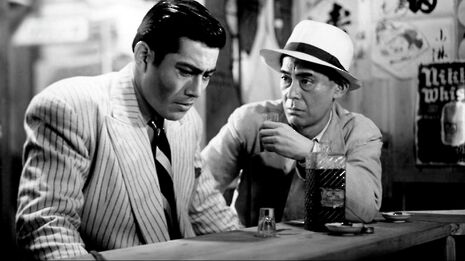VisCourse: Noir and Goodness
Lydia Sabatini explores the murky morality that lies beneath the monochrome

Film Noir is the label often applied to Hollywood crime films from the 1940s and 50s, and other subsequent films with a similar aesthetic. Often explored in these films is the nature of evil and corruption, its banality, allure and cynicism. Think of the iconic scene on the Ferris wheel in Carol Reed’s 1949 film The Third Man, where Orson Welles’ Harry Lime points to the tiny figures below and chillingly asks another character, and, of course, the viewer, “would you really feel anything if one of those dots stopped moving forever?”
It is not surprising that people who witnessed the horrors of World War 2 and experienced the ensuing disillusionment would be interested in interrogating evil and corruption. Goodness can even seem straightforward, even dull, compared with the taboo allure of evil. Yet some films choose to take the question, surely of more everyday importance to viewers, of how to do good in a world full of evil, seriously.
“Goodness can even seem straightforward, even dull, compared with the taboo allure of evil”
Akira Kurosawa’s 1948 film Drunken Angel is steeped in the drudgery of everyday life. The ills of society are pervasive, yet not attributed to any one individual or entity, and can therefore seem insurmountable. Kurosawa covertly criticises the corruption and hardship he sees in US-occupied Tokyo by centring the action on a murky, putrid and diseased swamp. Takashi Shimura plays an alcoholic doctor trying to do his job and treat people. He is often ignored, and the persistence of his failure evidently takes a toll on him, and he ends up becoming bristly and irritable, which perversely reduces his effectiveness.
The film mostly follows his attempts to get a young gangster to take his tuberculosis seriously, which fails miserably. But despite this, Kurosawa ends the film with a smiling schoolgirl, informing him that she is now tuberculosis free. Successes, however small and short-lived, remind us that goodness doesn’t always strive in vain, even if it often seems that way.
On the other hand, the limits and motivations behind those who act to oppose evil are given a more melodramatic in many “revenge” dramas, where the line between justice and retribution is blurred. In the post-war era Kurosawa also made The Bad Sleep Well (1960), in which the protagonist Kōichi Nishi has infiltrated the corporation that killed his father. When society makes legal justice difficult, if not impossible, our sympathies are often with those who try to right the wrong. But when Nihsi marries the CEO’s disabled daughter, and subjects some company grunts to violence and psychological abuse, the difference between righteous anger and reckless sadism becomes harder to define.
A similar ambiguity is used in the “moral dilemma” movie. Films such as Juan José Campanella ’s 2009 film The Secret in Their Eyes or Ben Affleck’s Gone Baby Gone (2007) centre on well-intentioned characters who come to find the system they are working and living within is fatally flawed. The films intertwine the character’s personal lives with the crimes they try to solve, so that the sudden moral dilemma presented at the end has emotional as well as philosophical weight.
To oppose evil, we have to be able to identify it. Bong Joon-ho’s Memories of Murder (2003) shows us the gulf between such moral abstractions and the difficulty of working within imperfect institutions. The film is a police procedural following a largely incompetent and under-resourced team trying to catch a serial killer, tackling a noir-like subject matter with a distinctive dark humour. Two of the policemen in the film have contrasting mantras they believe will allow them to locate the killer. The small-town policeman follows his instincts, often rounding up and beating up the usual suspects until a confession is elicited.
While this behaviour is clearly improper, there is something attractive in the idea that when faced with someone so hideously evil, we would be able to see it in their eyes. The other policeman is more meticulous, trusting in procedure, evidence and documents. The film shows that both methods can be devastatingly inadequate, and all good intentions remain thwarted. When trying to locate the evil we wish to stop we can find ourselves groping blindly in the dark
 News / Cambridge University disables comments following Passover post backlash 24 April 2024
News / Cambridge University disables comments following Passover post backlash 24 April 2024 Comment / Gown vs town? Local investment plans must remember Cambridge is not just a university24 April 2024
Comment / Gown vs town? Local investment plans must remember Cambridge is not just a university24 April 2024 News / Fitz students face ‘massive invasion of privacy’ over messy rooms23 April 2024
News / Fitz students face ‘massive invasion of privacy’ over messy rooms23 April 2024 Interviews / Gender Agenda on building feminist solidarity in Cambridge24 April 2024
Interviews / Gender Agenda on building feminist solidarity in Cambridge24 April 2024 Comment / Does Lucy Cavendish need a billionaire bailout?22 April 2024
Comment / Does Lucy Cavendish need a billionaire bailout?22 April 2024





